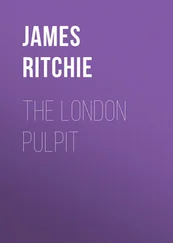James Ritchie - The Religious Life of London
Здесь есть возможность читать онлайн «James Ritchie - The Religious Life of London» — ознакомительный отрывок электронной книги совершенно бесплатно, а после прочтения отрывка купить полную версию. В некоторых случаях можно слушать аудио, скачать через торрент в формате fb2 и присутствует краткое содержание. Жанр: foreign_prose, на английском языке. Описание произведения, (предисловие) а так же отзывы посетителей доступны на портале библиотеки ЛибКат.
- Название:The Religious Life of London
- Автор:
- Жанр:
- Год:неизвестен
- ISBN:нет данных
- Рейтинг книги:3 / 5. Голосов: 1
-
Избранное:Добавить в избранное
- Отзывы:
-
Ваша оценка:
- 60
- 1
- 2
- 3
- 4
- 5
The Religious Life of London: краткое содержание, описание и аннотация
Предлагаем к чтению аннотацию, описание, краткое содержание или предисловие (зависит от того, что написал сам автор книги «The Religious Life of London»). Если вы не нашли необходимую информацию о книге — напишите в комментариях, мы постараемся отыскать её.
The Religious Life of London — читать онлайн ознакомительный отрывок
Ниже представлен текст книги, разбитый по страницам. Система сохранения места последней прочитанной страницы, позволяет с удобством читать онлайн бесплатно книгу «The Religious Life of London», без необходимости каждый раз заново искать на чём Вы остановились. Поставьте закладку, и сможете в любой момент перейти на страницу, на которой закончили чтение.
Интервал:
Закладка:
The children are educated in a way of which Christians have no idea. The Jewish free school in Brick Lane, with its three thousand children, is a sight to see. There is, besides, an infant school equally flourishing, and no poor Jew is relieved unless he sends his children to school. In the visiting of the sick, in the care of the poor, all take their share. I believe a synagogue is a little commonwealth in which the rich help the poor, most frequently by way of small loans, and in which the strong take care of the weak. In these works of beneficence all take their share, the humblest as well as those of more exalted rank. The Jewish M.P. takes his place at the Board of Guardians. The Jewish Countess will not only give of her wealth, but will leave her stately home and seek out the abode of sorrow and distress. Charity is inculcated in the Talmud as the first of duties; and, if heaven is won by good works, the Jews are safe and sure.
As a theology, to an outsider, Judaism seems ritualism in excelsis .
The Jewish faith is contained in the Creed and the Shemang. Of the two, the latter is the more important. It is a declaration of the unity of God, the first utterance of the child, the last of the devout Jew as the watchers stand by his bedside, at the head of which is the Shechinah, or Divine presence, and at the foot of which, with outstretched wing, waiting for the last breath, hovers the angel of death. The Creed, which every Jew ought to believe and rehearse daily, but which they treat as Churchmen do their Thirty-nine Articles, is as follows: —
1. I believe, with a perfect faith, that God (blessed be His name!) is the Creator and Governor of all created beings, and that He alone has made, does make, and ever will make, every production.
2. I believe, with a perfect faith, that God (blessed be His name!) is one God, and that there is no unity whatever like unto Him, and that He alone is our God, who was, is, and will be eternally.
3. I believe, with a perfect faith, that the Creator (blessed be His name!) is not corporeal, nor is He subject to any of those changes that are incidental to matter, and that He has no similitude whatever.
4. I believe, with a perfect faith, that the Creator (blessed be His name!) is both the first and last of all things.
5. I believe, with a perfect faith, that to the Creator (blessed be His name!) yea, to Him only, it is proper to address our prayers, and that it is not proper to pray to any other being.
6. I believe, with a perfect faith, that all the words of the prophets are true.
7. I believe, with a perfect faith, that the prophecy of Moses our instructor (may his soul rest in peace!) was true, and that he excelled all the sages that preceded him or they who may succeed him.
8. I believe, with a perfect faith, that the law which we have now in our possession is the same law which was given to Moses by our instructor.
9. I believe, with a perfect faith, that this law will never be changed, that the Creator (blessed be His name!) will never give us any other law.
10. I believe, with a perfect faith, that the Creator (blessed be His name!) knoweth all the actions and thoughts of mankind, as it is said, “He fashioneth their hearts, and knoweth all their works.”
11. I believe, with a perfect faith, that the Creator (blessed be His name!) rewards those who observe His commandments, and punishes those who transgress them. (12.) The Jew believes in the coming of the Messiah; and (13), in the resurrection of the dead.
The Jews in London are divided into three communities – the Reformed, the Ashkenasim , or Polish and German Jews, and the Sephardim , or Portuguese and Spanish. These latter pride themselves on their ancient descent, and especially on their nationality. Their Church, as we have said, is the oldest in London; their rabbi is Dr. Artom, and their service differs from that of the Ashhenasim in matters of detail not of faith. Of course both take their stand upon the Pentateuch, which they term the Torah or law, a portion of which is read every Sabbath; but, according to the rabbinists, Moses received two laws on Mount Sinai, one written, the other unwritten. This latter was transmitted down from generation to generation by word of mouth until after the destruction of Jerusalem, when it was committed to writing. This work is called Mishna , or repetition. In process of time it became a text-book in the schools of Palestine and Babylon, and lectures were delivered on it and comments made by rabbis more or less learned and devout. In course of time these comments and lectures were collected together into one work under the title of Gemara , completion. The Talmud , which means doctrine, contains the two. There are two Talmuds in existence. One contains the decisions of the Palestine rabbis, collected and published somewhere in the fourth century; the other contains similar decisions on the part of the learned divines of Babylon. The difference between the two is exclusively in the Gemara . The Babylonian Talmud is the one in common use. It is for this Talmud, long too much neglected by Christians, that the Jews have contended for ages, and it is for this Talmud an able writer, in an article in the “Quarterly,” which produced an immense sensation at the time, eloquently pleaded, much to the astonishment, most undoubtedly, of those bigoted ecclesiastics who, deeming the traditions of the Romanist Fathers equal in authority with the Bible, look down upon the older and truer traditions of the Talmud with the contempt which ignorance always cherishes for what it cannot or does not understand. Sentiments, as the learned Professor Hurwitz wrote, worthy of Plato have been described as rabbinical reveries, and their authors arraigned of impiety on no better grounds than what the detractors supplied by wantonly imposing their own literal sense on expressions evidently and unmistakeably figurative.
In the synagogue is the worship daily or weekly of the devout Jew performed, for the aim of that worship is to connect itself with the daily life. Dr. Arnold’s idea of the Church and State being synonymous – an idea as old as the judicious Hooker’s Ecclesiastical Polity – is undoubtedly in its origin Jewish. The officers of the synagogue are a complete political as well as religious administration. A synagogue forms a little world of its own. A volume would be requisite to tell of the officers of the synagogue and of their various duties. There is among them no separation into lay and secular. The community consists of three kinds of members – the Cohen or priest, the Levite, and the Israelite. A minister must often support himself, but his ministry never ceases. To the last hour of his life he maintains his ministerial character. “The rabbis are men of great learning; and now in the Jews’ College the students,” writes a report just received, “have the advantage of a careful and systematic clerical education, and an equally valuable advantage, an example of piety and earnestness in their teachers.”
The oldest synagogue in London is, as we have said, that of the Sephardim, in Bevis Marks. Let us go there first. All Jewish synagogues are alike; all the men keep their hats on, and wear a scarf round their shoulders, hanging down to their knees. At one time, in another respect, they were much alike – that was in the use of a service not understood by the people generally. All this is altered now. Within the last thirty years there has been a great change for the better. There are but few even of the poorest Jews who do not understand Hebrew.
The governing officers of the synagogue are the Wardens, the Treasurer, the Overseer, and the Elders. The clerical officers are the Chazan, or reader, and the Shama, or second reader, and clerk. The ark is always situated in the south-east end of the synagogue, to direct the worshipper towards Jerusalem. The ark contains the law, written on vellum, fastened to rollers, on the tops of which are little crowns of silver surrounded by bells. The rolling and unrolling of the Law is a ceremony carefully observed every Sabbath. In form the Bevis Marks synagogue much resembles one of our old Nonconformist places of worship before they were improved according to the requirements of modern taste. You pass into it from behind some raised benches, on which several stout old gentlemen are gesticulating with all their might. A little further on is the reading desk, where the reader, with his hat on, his scarf round his shoulders, is performing his appointed task – at one time singly, at another time with the energetic assistance of the whole house. The readers wear black gowns. The faces of the reader and the rabbi are alike turned to the ark, before which a lamp perpetually burns. Of course there never are pews, but benches, under which are lockers, in each of which the worshipper deposits his scarf and prayer-book. In the synagogues of the Ashkenasim the benches nearest the ark, where the chief rabbi stands, are considered the most honourable; but the Spanish and Portuguese Jews make no difference in this respect. In the evening the synagogue is lighted up by means of large tapers and old-fashioned gas-chandeliers. In the service all join with more or less fervour. It consists entirely of reading and singing prayers and certain portions of Scripture. No sermon or lecture, except on Sabbaths and festivals, is necessary or usual. The melodies used are ancient, and the reading is of a very peculiar character, and not to be confounded with chanting or intoning as known to Christians. Most of the congregation in Bevis Marks seem to keep time with their bodies, as the sound rises and dies away. Also every other sentence begins with a woah-wooah sound of a monotonous cast; but all seem to enjoy it, especially the little Hebrew lads, who make more noise than anybody else. Sometimes the people stand up, at other times they sit down – they never kneel; but the stranger realizes little solemnity while the service is performing, and many of the Jews are quite ready to enter into a little secular conversation, or, if need be – as we can testify from personal observation – to quarrel. The prayers are chiefly of a laudatory, a confiding, a grateful, reverent character, and in a style, as regards composition, indicative of a foreign origin. Indeed, all the time the service is performing – the principal one is on the Saturday morning, and very long – you feel as if you were a stranger, as if you had no business there; that to the hook-nosed, black-haired, dark-eyed men around, you are a poor pale-faced, flat-nosed Saxon, to be preyed on and victimized to any extent. Here and there you see a foreigner in the picturesque garb of the East, looking sad and solitary as if he really remembered Zion, as if he had walked along the shores of Galilee, rested beneath the shade of the cedars of Lebanon, or had drank of
Читать дальшеИнтервал:
Закладка:
Похожие книги на «The Religious Life of London»
Представляем Вашему вниманию похожие книги на «The Religious Life of London» списком для выбора. Мы отобрали схожую по названию и смыслу литературу в надежде предоставить читателям больше вариантов отыскать новые, интересные, ещё непрочитанные произведения.
Обсуждение, отзывы о книге «The Religious Life of London» и просто собственные мнения читателей. Оставьте ваши комментарии, напишите, что Вы думаете о произведении, его смысле или главных героях. Укажите что конкретно понравилось, а что нет, и почему Вы так считаете.












